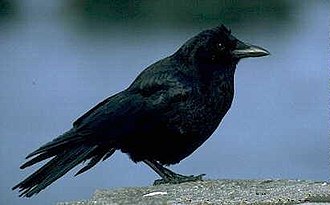Difference between revisions of "Field Guide/Birds/Corvus brachyrhynchos"
(interwiki +pt) |
|||
| (One intermediate revision by the same user not shown) | |||
| Line 35: | Line 35: | ||
==Crows in slang== | ==Crows in slang== | ||
| − | |||
The abundance of the American Crow in both rural and urban environments have made them very familiar to all Americans. Their name has been applied in numerous ways to the vernacular. | The abundance of the American Crow in both rural and urban environments have made them very familiar to all Americans. Their name has been applied in numerous ways to the vernacular. | ||
* Loud, vain bragging is sometimes referred to as "crowing". | * Loud, vain bragging is sometimes referred to as "crowing". | ||
| − | * Similarly, to "eat crow" is to suffer | + | * Similarly, to "eat crow" is to suffer embarrassment after having previously boasted. |
* A [[scarecrow]] is a [[dummy]] shaped and dressed like a [[human]] and placed inside a crop to frighten away crows and other birds. | * A [[scarecrow]] is a [[dummy]] shaped and dressed like a [[human]] and placed inside a crop to frighten away crows and other birds. | ||
| Line 67: | Line 66: | ||
==Video links== | ==Video links== | ||
* [http://www.hbw.com/ibc/phtml/especie.phtml?idEspecie=8286 External page with video footage] | * [http://www.hbw.com/ibc/phtml/especie.phtml?idEspecie=8286 External page with video footage] | ||
| − | |||
[[Category:Corvus]] | [[Category:Corvus]] | ||
| + | [[de:Amerikanerkrähe]] | ||
[[fr:Corneille d'Amérique]] | [[fr:Corneille d'Amérique]] | ||
| + | [[pt:Corvus brachyrhynchos]] | ||
[[ru:Американская ворона]] | [[ru:Американская ворона]] | ||
| − | |||
Revision as of 17:18, 21 February 2006
The American Crow (Corvus brachyrhynchos) is slightly smaller than the European Carrion Crow in overall size (39-49 cm in length) and also has a proportionately smaller bill. Feathers are black, with a purple or blue iridescence in some lights. Legs, feet and bill are also black. Several regional forms are recognized and differ in bill proportion and overall size from each other across North America, generally smallest in the southeast and the far west. The Northwestern Crow Corvus caurinus is very closely related to the American Crow and indeed structurally, they almost blend into each other in northern Oregon though the voice remains one of the principal differences between these two close species.
Range: Occurring from British Columbia to Newfoundland in the north, and the Gulf of Mexico to Florida in the southern parts of its range and includes virtually all types of country from wilderness, farmland, parks, open woodland to towns and major cities. This bird is generally a permanent resident, but many birds in the northern parts of their range migrate short distances south. Outside of the nesting season, these birds often gather in large communal roosts at night.
Diet: A typical crow taking invertebrates of all types, carrion, scraps of human food, seeds, eggs and nestlings, stranded fish on the shore and various grains. It also, like most crows, scavenges at rubbish dumps. Where available, corn is a favorite food. They are also fond of discarded scraps of fast food, especially french fries which can be carried away easily in their strong beaks.
Nest: These birds build bulky stick nests, nearly always in trees but sometimes also in large bushes and, very rarely, on the ground. They will nest in a wide variety of trees, including large conifers, although oaks are most often used. Three to six eggs are laid and incubated for 18 days. The young are fledged usually by about 35 days. Normally single nesting, the species has been recorded as nesting in small colonies in the western parts of its range.
Voice: The most usual call is a loud, short, and rapid "caah-caah-caah". Usually, the birds thrust their heads up and down as they utter this call. Crows can also produce a wide variety of sounds and sometimes mimic noises made by other birds and animals.
==Sound link== American Crow call
Status: Despite attempts by humans in some areas to drive these birds away, they remain widespread and very common. Widely regarded as a pest, crows tend to be wary around humans, unlike seagulls, mallards, or feral pigeons.
Crows in slang
The abundance of the American Crow in both rural and urban environments have made them very familiar to all Americans. Their name has been applied in numerous ways to the vernacular.
- Loud, vain bragging is sometimes referred to as "crowing".
- Similarly, to "eat crow" is to suffer embarrassment after having previously boasted.
- A scarecrow is a dummy shaped and dressed like a human and placed inside a crop to frighten away crows and other birds.
- A crowbar is a hook shaped metal rod used to pry open objects and remove nails.
- A crow's nest is a small platform near the top of a ship's mast used for observation and navigating.
- "As the crow flies" refers to the shortest distance between two points by air.
- "Crows feet" is a term for Y shaped wrinkles on the skin, usually the face.
- "Jim Crow", originally the name of 19th century minstrel character, has come to define all blackface performances of that era, as well as laws - particularly in the American South - that segregated blacks.
- Likewise, the name "crow" was often applied as a mildly insulting, early 20th century term for African-Americans. White vaudeville comedians Moran and Mack recorded a popular series of skits in the 1920s called "Two Black Crows", speaking in exaggerated Black American accents.
Also see Crow (disambiguation)
External image links
Video links
de:Amerikanerkrähe fr:Corneille d'Amérique pt:Corvus brachyrhynchos ru:Американская ворона

